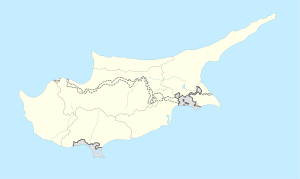Marathovounos
| Marathovounos | |
|---|---|
| Μαραθόβουνος (Greek) Ulukışla (Turkish) | |
| Location in Cyprus | |
| Coordinates: 35°13′15″N 33°37′1″E / 35.22083°N 33.61694°ECoordinates: 35°13′15″N 33°37′1″E / 35.22083°N 33.61694°E | |
| Country |
De jure De facto |
| District |
De jure Famagusta District De facto Gazimağusa District |
| Time zone | EET (UTC+2) |
| • Summer (DST) | EEST (UTC+3) |
Marathovounos (Greek: Μαραθόβουνος, Turkish: Ulukışla) is a village in the Famagusta District of central Cyprus.
It is named after the fennel (Marathos) an aromatic and flavourful herb used in cooking and folk medicine. It was after the 1974 Turkish invasion that it was renamed Ulukışla, meaning "holy barracks" or "large barracks" in Turkish. Marathovounos is 2 km north of the village of Angastina, 4 km south of the village of Tziados and 39 km from its provincial capital Famagusta, to the east. It is 65 meters above sea level.
Marathovounos was built on a hillock called Vounos (Greek for hill) on the northern edge of the Massaoria plain. Evidence of mid to late Bronze Age habitation was discovered there. There's also an ancient Basilica at nearby Petrera. There is speculation that there was an earlier Christian village at Vouno with a small church that dates from the 1700s. It is possible that one of the walls of Prophitis Ilias (Prophet Elias), the church of Marathovounos, incorporated an old fresco from this small church.
In the early 1820s Greek Cypriots found refuge in the caves around the hillock of Vouno from Agia Paraskevi a nearby village to the north which had been established in 1571. This was after a wave of massacres that were inflicted on the Greek Cypriots throughout the island by the Ottoman administrators who feared that there would be a similar uprising for independence as it occurred in Greece in 1821. “The first inhabitants of the village moved in 1821 from Greek houses from the place where we find today the Turkish village of Tziados, next to Marathovounos … The fact that the mosque of Tsiados is the church of Agia Paraskevi which was turned to a mosque and until 1974 it had no minaret is another proof to the Greek Cypriots that the village that was built in 1571 was Agia Paraskevi. In 1821 the Turks killed 450 young men within the church of Agia Paraskevi. The pressure on the Greeks from the Turkish authorities forced young couples to take the decision to shift to spare themselves the vilification and oppression. (Translation from the Greek), Posted: 7 September 2001. After this event Agia Paraskevi was renamed Tsiados and only Turks lived there.
Between Marathovounos and Tsiados exists the exoklisi (outer chapel) of Timiou Stauvrou (Honourable Cross) at the location of the cemetery of Marathovounos. Since the invasion a digger has flattened the cemetery and the rubble has been deposited within the fallen walls of the old chapel.
...
Wikipedia

